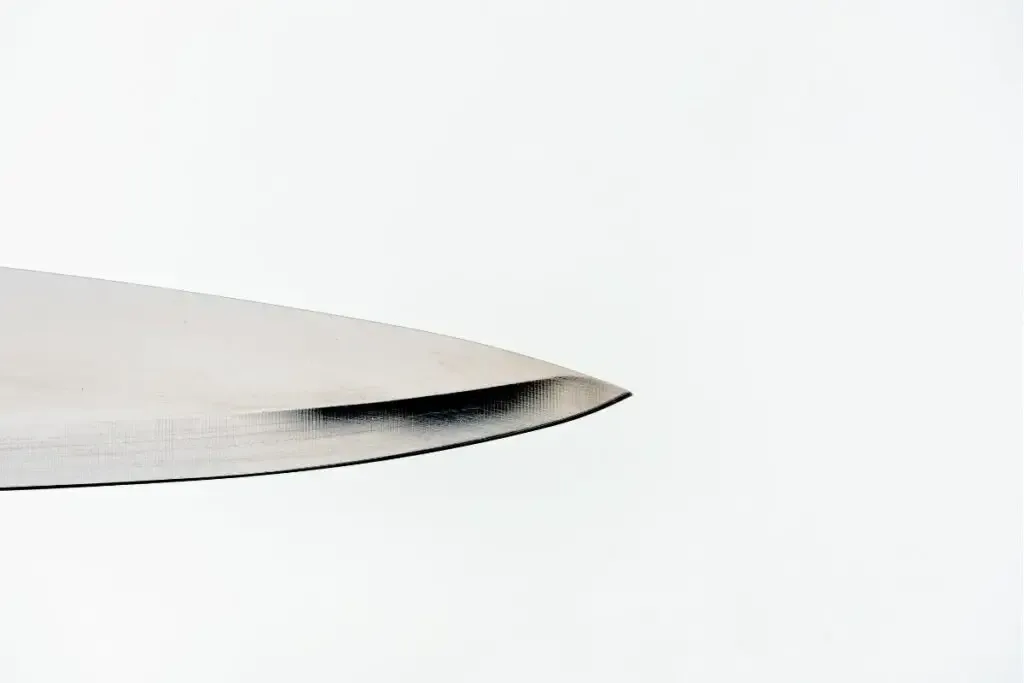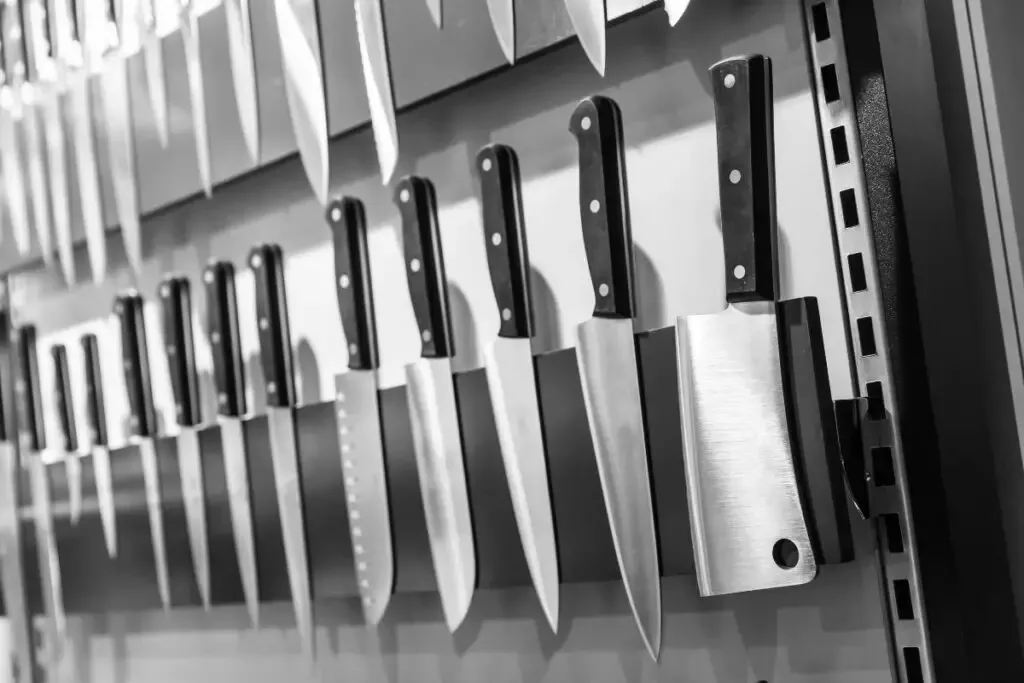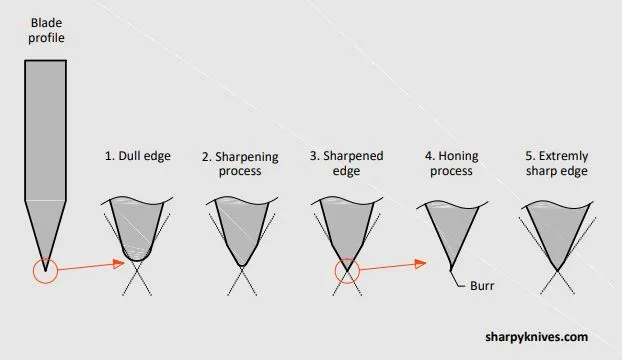As an Amazon Associate, we earn from qualifying purchases with no additional costs for you.
Most knife owners know that there is no point in a knife that is not sharp. The challenge, however, comes in keeping the knife sharp. A knife that loses sharpness and does not hold the sharp edge can be a frustrating thing when you reach for the knife and find the edge unsatisfactory. Why do knives lose sharpness, and why do some knives lose sharpness so fast?
Knives may lose their sharpness fast because of several possible reasons. They could be made from inferior steel, the angle on the edge is too thin, the knife has been sharpened incorrectly, or the knife is being used for a purpose that it was not intended for, or they are stored incorrectly.
The aspects involved in a knife retaining its sharp, functional edge are the result of numerous factors, some of which relate to the knife and its construction, and others are a direct result of how the knife is used and how it is sharpened.
Understanding your knife, the steel it is made from, and the type of edge on the blade is important to know why your knife loses its edge.
If you are interested in checking out the best whetstones for your knives we recommend and use you can find them by clicking here (Amazon link).
Why A Knife Loses Its Sharpness So Fast

A knife that does not retain its edge can be frustrating because you have to re-establish the edge more frequently on the blade, and the knife is often dull when you want to use it. You may then not have the time or opportunity to get out your sharpening kit and put the edge back on the knife.
You have two options open to you here; use the knife blunt and force it through, sharpen it first before using it, or select another knife from your collection to use for the task.
But why do we have this problem with knives that do not hold their edge and that lose their sharpness so fast? Is there anything action that can be taken to remedy this problem and make the knife stay sharp for longer?
Type Of Steel The Knife Is Built From
One reason that the knife may not be holding the sharp edge is that it is not made from steel that is capable of holding an edge for a long time.
If the steel is too soft, the edge will wear away quickly, or it will fold over easily, making the knife become dull after a few uses. This kind of knife will need to be sharpened frequently, and it will also wear down quickly during the sharpening process.
Poor steels are usually only seen on cheaper knives, where sub-standard steel is used to make the knife. It is not very little you can do to improve the edge-holding capability of this knife.
If you are an experienced knife maker, you could try to re-do the heat treating and tempering of the knife, but if you do not know the exact steel the knife is made from, this could be a hit-and-miss exercise.
The effort involved in doing this would probably not be worthwhile, and it would probably be better to discard the knife and purchase a better-quality knife.
High carbon steels hold their edge better than most other metals. Stainless steel is also popular because of its corrosion resistance, but it does not hold an edge as well as high carbon steel.
So if you are searching for a durable, reliable blade that will hold an edge well, look for a knife made from one of these quality steels such s 1095, 5160, O1 tool steel, and stainless steel, which has added chromium.
Stainless steel knives would suit most purposes and are popular in the kitchen because of their stain and corrosion resistance, but they are not as tough as plain carbon steel knives.
Type Of Edge On The Blade

The type of edge that is put on the knife would have an effect on how long the knife stays sharp. The angle that is used to create the secondary bevel for the sharp edge will play a determining factor in the edge retention.
A knife that is sharpened to a thin razor-edge will not be as durable as a knife that is not sharpened to this degree. If the angle of the secondary bevel is too shallow, there is not enough thickness or meat behind the sharp edge to give it support and strength.
Thus, the edge will be sharp, but it will not be durable, and it will lose sharpness quickly. You will also need to sharpen this knife regularly to keep it sharp.
It is for this reason that a straight razor is stropped on a leather strop before each use and often during the shaving process to keep it sharp enough for the task.
It is possible, therefore, to make a knife too sharp, which will result in the knife not being able to retain the sharpness for long.
Only sharpen the knife to the level of sharpness required and to an angle that is appropriate for the style of blade and intended use of the knife.
TIP: Have you ever thought about why knives have a false edge? Yes, some knives have the false edge and you can find out why in the article below:
3 Main Reasons: Why Do (Some) Knives Have A False Edge?
The Knife Is Used For The Wrong Purpose
A knife that is used for the wrong task or purpose will not hold its edge for long. It is for this simple reason that we have knives designed for particular purposes.
This is particularly noticeable in knives that are designed for use in the kitchen. You have chef knives, paring knives, bread knives, boning knives, cleavers, utility knives, cheese knives, peeling knives, and the list goes on.
While many of these knives could have multiple uses, they are designed with a particular task in mind, and the edge that is put on the knife is appropriate for the intended task.
If you use a peeling knife as a boning knife, for example, you are going to quickly see a deterioration in the sharpness of the knife. This is because the edge on the knife was not intended for this kind of work, and it will quickly lose sharpness.
Likewise, if you use a skinning knife to baton firewood, you cannot expect it to retain its edge for the purpose of skinning an animal effectively.
Multi-purpose style knives such as bushcraft knives do not have a very acute angle to their secondary bevel.
As a result, they have more metal behind the sharp edge, which makes the edge stronger and more durable, and these types of knives retain their edge for longer periods and can handle much more abuse than a thin razor edge.
To rectify this problem, simply re-establish the edge on the knife and then only use it for its intended purpose. If you find that you continually reach for a knife to use and it is not the right knife for general purpose tasks, you may need to consider getting a good quality utility knife.
A utility knife is intended to be used in a multi-purpose role and will have the steel, bevel angle, and edge-type that is appropriate for a range of tasks, and it will keep its edge for longer.
Impact Of Incorrect Knife Usage On Sharpness
One of the most common reasons why knives lose their sharpness quickly is incorrect usage. Knives are designed with specific tasks in mind, and using a knife for a purpose other than its intended use can lead to rapid dulling of the blade. Here’s how incorrect usage can impact your knife’s sharpness:
- Cutting on Hard Surfaces. Cutting on hard surfaces like glass, marble, or metal can quickly dull your knife. These materials are harder than the steel of the knife and can cause the edge to chip or become misaligned. Always use a cutting board made from softer materials like wood or plastic to preserve your knife’s edge.
- Using the Knife as a Tool. Knives are designed for cutting, not for prying open jars, unscrewing screws, or scraping burnt food off pans. Using your knife as a makeshift tool can put undue stress on the blade and cause it to become dull or even break.
- Incorrect Cutting Techniques. Using incorrect cutting techniques can also dull your knife. For example, using a sawing motion when a slicing motion is needed can cause unnecessary wear and tear on the blade. Always use the correct cutting technique for the task at hand.
- Using the Wrong Knife for the Task. Different knives are designed for different tasks. For example, using a delicate paring knife to cut through bone can quickly dull the blade or even cause it to chip. Always use the right knife for the task to ensure your knife stays sharp.
- Dishwasher Cleaning. While it may seem convenient, cleaning knives in the dishwasher can cause them to become dull. The high heat and harsh detergents can damage the blade, and the knives can knock against other utensils, causing the edge to become misaligned. Always hand wash your knives to keep them sharp.
Using your knife correctly can significantly extend the time between sharpenings and ensure your knife stays sharp and effective for longer. Always remember to use the right knife for the task, use the correct cutting techniques, and take care when cleaning and storing your knife.
The Knife Is Stored Incorrectly

The correct storage of a knife is important to it retaining its edge and being ready to use when you need it. Certain knife storage options are better than others to assist in keeping your knives sharp.
A knife drawer in a kitchen draw where all the knives are just loosely tossed is probably one of the most damaging ways to store your knives. The constant jostling of the knives against each other and other utensils will dull the edge of the knives and require them to be frequently sharpened.
Likewise, knife storage blocks that are made of wood can result in a knife losing sharpness as the edge is dragged against the wood of the block each time it is withdrawn and replaced.
The best way to store kitchen knives is on a magnetic knife holder on the wall, but make sure it is a good quality holder. Bushcraft knives are best stored in the sheath that was made for them.
If your bushcraft knife has a leather sheath and you don’t use it daily, it is best to store the knife outside of the sheath, wrapped in a soft cloth. Leather absorbs moisture over time and could cause the knife to rust.
TIP: One of the most popular ways on how to store knives is using magnetic strips in the kitchen. Find out if magnetic strips can damage your knives in the article below:
Do Magnets Damage Knives? Here’s the Complete Answer
The Knife Has Been Sharpened Incorrectly

Among novice knife owners and knife sharpeners, incorrect sharpening is a frequent cause for a knife losing its sharpness quickly.
An incorrectly sharpened knife may feel sharp immediately after sharpening, but after using it once or twice it feels dull again. This is a clear indication that the sharpening process has not been done correctly.
The most common sharpening mistakes that result in this are using the wrong angle to sharpen the knife and the incorrect removal of the burr.
The solution to this particular problem of your knife losing sharpness is to work on your sharpening skills and pay close attention to the angles at which you sharpen the knife and make it constant.
Sharpening the knife too far and removing the burr on a stone that is too rough will also have this result. The burr should be gently removed on a strop or a very high gritstone.
TIP: Are you looking to buy a new whetstone? Check out our recommendations (we personally use the first three ones):
Our PRO choice whetstones combo (Amazon links):
- Fixing stone: Whetstone SHAPTON Ceramic KUROMAKU #320
- Sharpening stone: Suehiro CERAX soaking whetstone: Medium #1000
- Finishing stone: Whetstone SHAPTON Ceramic KUROMAKU #5000
Our budget choice (Amazon link): Sharp Pebble Extra Large Sharpening Stone Set
Conclusion
A well-made knife that is used for its intended purpose should not need frequent sharpening unless it is in daily use.
If you are finding that you are sharpening your knives more often than you should, you should take some time to establish why this is the case.
The solution could be something as simple as storing your knives differently, or using the right knife for the right task, or adjusting the angle of the edge.
Using, sharpening, and storing your knives correctly will not only keep the knives sharper for longer but will extend the usable lifespan of the knife.
TIP: Do you know how to properly sharpen a knife with a whetstone? Whetstones are the most popular sharpeners among chefs. Check out the complete guide in the article below:
Step-By-Step GUIDE: How To Sharpen A Knife With A Whetstone
